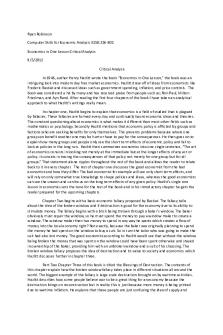Applications of derivatives in economics PDF

| Title | Applications of derivatives in economics |
|---|---|
| Author | Anonymous User |
| Course | B.a(Hons) Business Economics |
| Institution | University of Delhi |
| Pages | 9 |
| File Size | 257.6 KB |
| File Type | |
| Total Downloads | 97 |
| Total Views | 148 |
Summary
Download Applications of derivatives in economics PDF
Description
Applications of derivatives in economics The use of derivatives in economics is one that is indispensable. Some key uses of derivatives in economics are:
1) Marginal cost, revenue and profit Marginal cost The first derivative of the cost function is called marginal cost. At each level of production and time period being considered, marginal costs include all costs that vary with the level of production, whereas other costs that do not vary with Hange
production are fixed and thus have no marginal cost. Marginal cost= Change in TC/Change in Quantity MC(Q)= dC/dQ Marginal Revenue The first derivative of the revenue function gives us marginal revenue. Marginal revenue =Change in TR/ Change in Quantity MR(Q)= dR/dQ Hange
Marginal Profit The first derivative of the profit function is marginal profit. MP(Q)= dP/dQ Marginal profit can also be obtained by subtracting the derivative of marginal cost from the derivative of marginal revenue. MP=MR-MC
Hange
Profit maximisation An assumption in classical economics is that firms seek to maximise profits. Hange
Profit = Total Revenue (TR) – Total Costs (TC). Therefore, profit maximisation occurs at the biggest gap between total revenue and total costs. A firm can maximise profits if it produces at an output where marginal revenue (MR) = marginal cost (MC)
Hange
Hange
Revenue maximisation Revenue maximisation is a theoretical objective of a firm which attempts to sell at a price which achieves the greatest sales revenue. This would occur at the point where the extra revenue from selling the last marginal unit (i.e. the marginal revenue, MR, equals zero). If marginal revenue is positive, an extra unit sold must add to total revenue and revenue maximisation will not have been reached. Only when marginal revenue is zero will total revenue have been maximised. Stopping short of this quantity means that an opportunity for more revenue has been lost, whereas increasing sales Hange
beyond this quantity means that MR becomes negative and TR falls. This can be seen in the following graph, with revenue maximisation at output Q, and at point A on the AR curve.
Hange
3) Cost minimization Cost is minimized at the levels of capital and labor such that the marginal product of labor divided by the wage (w) is equal to the marginal product of capital divided by the rental price of capital (r).
Hange...
Similar Free PDFs

IN A Nutshell Derivatives
- 1 Pages

Derivatives
- 7 Pages

Economics in one lesson
- 2 Pages

Economics in one lesson
- 33 Pages

applications of calculus ass
- 13 Pages

Applications of Diagonalization
- 3 Pages
Popular Institutions
- Tinajero National High School - Annex
- Politeknik Caltex Riau
- Yokohama City University
- SGT University
- University of Al-Qadisiyah
- Divine Word College of Vigan
- Techniek College Rotterdam
- Universidade de Santiago
- Universiti Teknologi MARA Cawangan Johor Kampus Pasir Gudang
- Poltekkes Kemenkes Yogyakarta
- Baguio City National High School
- Colegio san marcos
- preparatoria uno
- Centro de Bachillerato Tecnológico Industrial y de Servicios No. 107
- Dalian Maritime University
- Quang Trung Secondary School
- Colegio Tecnológico en Informática
- Corporación Regional de Educación Superior
- Grupo CEDVA
- Dar Al Uloom University
- Centro de Estudios Preuniversitarios de la Universidad Nacional de Ingeniería
- 上智大学
- Aakash International School, Nuna Majara
- San Felipe Neri Catholic School
- Kang Chiao International School - New Taipei City
- Misamis Occidental National High School
- Institución Educativa Escuela Normal Juan Ladrilleros
- Kolehiyo ng Pantukan
- Batanes State College
- Instituto Continental
- Sekolah Menengah Kejuruan Kesehatan Kaltara (Tarakan)
- Colegio de La Inmaculada Concepcion - Cebu









